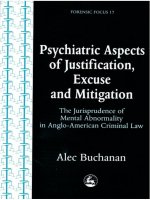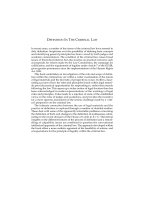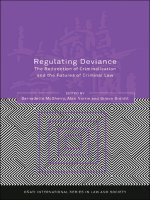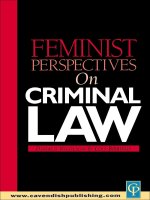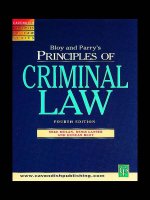Rethinking Criminal Law docx
Bạn đang xem bản rút gọn của tài liệu. Xem và tải ngay bản đầy đủ của tài liệu tại đây (42.64 MB, 927 trang )
Rethinking
Criminal
Law
This page intentionally left blank
Rethinking
Criminal
Law
George
P.
Fletcher
OXPORD
UNIVERSITY
PRESS
2000
OXFORD
UNIVERSITY
PRESS
Oxford
New
York
Athens Auckland Bangkok Bogota Buenos Aires Calcutta
CapeTown Chennai DaresSalaam Delhi Florence Hong Kong Istanbul
Karachi
Kuala Lumpur Madrid Melbourne Mexico City Mumbai
Nairobi Paris
Sao
Paulo Singapore Taipei Tokyo Toronto Warsaw
and
associated companies
in
Berlin
Ibadan
Published
by
Oxford University Press, Inc.
198
Madison Avenue,
New
York,
New
York
10016
Oxford
is a
registered trademark
of
Oxford
University
Press
All
rights reserved.
No
part
of
this publication
may be
reproduced,
stored
in a
retrieval system,
or
transmitted,
in any
form
or by any
means,
electronic,
mechanical, photocopying, recording,
or
otherwise,
without
the
prior permission
of
Oxford University Press.
Library
of
Congress Cataloging-in-Publication Data
Fletcher,
George
P.
Rethinking
criminal
law /
George
P.
Fletcher.
p. cm.
Originally
publish^
BogtQB
•
Little, Brown,
c
.l?78.
Includes
bibliographical references
and
index.
ISBN
0-19-513695-0
1.
Criminal law.
2.
Criminal liability.
I.
Title.
K5018.F57
2000
345—dc21
99-086719
135798642
Prin
ted in the
United States
of
America
on
acid-free
paper
Copyright(c) 2000 Oxford University Press
To
Fanny Fletcher Naxon
a
woman
of
valor
This page intentionally left blank
Contents
Preface
Table
of
Abbreviations
and
Short-Form
Citations
xxv
Part I—Rethinking Specific Offenses i
Chapter
One:
The
Topology
of
Theft
3
§1.1.
Introduction
3
§1.1.1.
Larceny
and
Embezzlement
4
§1.1.2.
Obtaining
Property
by
False
Pretenses
10
§1.2.
Points
of
Stress
in the
Topology
of
Theft
13
§1.2.1.
Receiving
the
Chattel with
a
Fraudulent Purpose
15
§1.2.2.
The
Problem
of
Finders
18
§1.2.3.
The
Problem
of
Mistaken Delivery
20
§1.2.4.
The
Problem
of
Delivery
from
a
Third Party
22
§1.2.5.
A
Guide
to
Analyzing
Theft
Offenses
26
A.
Custody Acquired
at Tj 28
B.
Possession Acquired
atT1 28
C.
Title Acquired
at T! 29
§1.3.
The
Interests
Protected
by
Theft Offenses
30
§1.3.1.
An
Earlier Understanding
31
§1.3.2. Larceny
as a
Crime Against
Possession
35
§1.3.3. Protecting Objects
and
Protecting
Economic Interests
39
§1.3.4.
The
Interests Protected
in
Punishing Fraud
49
Chapter
Two: Common-Law Larceny
and
Its
Metamorphosis
59
§2.1.
Enigmas
of the
Common
Law 59
vii
xix
Contents
§2.1.1.
Possessorial
Immunity
61
§2.1.2. Enigmas
of the
Common Law:
The
Carrier's Case
66
§2.1.3.
The
Problem
of
Staged Larceny
70
§2.2.
A
Theory
for
Resolving
the
Enigmas
of the
Common
Law 76
§2.2.1.
Possessorial Immunity
81
§2.2.2.
Carrier's Case
83
§2.2.3. Staged Larceny
86
§2.2.4.
The
Rationale
of
Manifest
Criminality
88
§2.3.
The
Metamorphosis
of
Larceny
90
§2.3.1.
The
King
v.
Pear
90
§2.3.2. Reinterpreting
the
Tradition
94
§2.3.3.
The
Intellectual Background
100
§2.4. Judicial Expansion
of the
Common
Law 103
§2.4.1. Liability
of
Finders
104
§2.4.2.
The
Problem
of
Mistaken Delivery
107
§2.4.3. Legislative Consolidation
110
Chapter Three:
Two
Patterns
of
Criminality
115
§3.1. Abstracting
from
the
History
of
Larceny
115
§3.1.1.
The
Pattern
of
Manifest Criminality
115
§3.1.2.
The
Pattern
of
Subjective Criminality
118
§3.1.3.
Maxims Common
to
Both Patterns
of
Liability
119
§3.2. Related
Theft
Offenses
122
§3.2.1.
Embezzlement
122
§3.2.2.
False Pretenses
124
§3.2.3. Burglary
124
§3.2.4.
New
Offenses
Akin
to
Burglary-Without-Breaking
128
§3.3. Attempts
131
§3.3.1.
Two
Doctrinal
Issues
in
Attempts
135
§3.3.2.
Objectivist Approaches
and the
Theory
of
Attempts
139
viii
Contents
A.
Stages
of
Commission
140
B.
The
Criterion
of
Danger
141
C.
Apprehension
and
Unequivocal
Conduct
141
§3.3.3.
Manifest
Criminality
and
Impossible Attempts
146
A.
The
Shooting Cases
149
B.
The
Poisoning Cases
152
C.
The
Empty Receptacle Cases
154
D.
Receiving Stolen Property
154
§3.3.4.
A
General Theory
of
Attempting
157
§3.3.5.
The
Ascendancy
of
Subjective Criminality
166
§3.3.6.
The
Principles Behind
the
Subjectivist
Theory
of
Attempts
170
§3.3.7.
The
Prospects
of a
Subjective Theory
of
Attempts
174
§3.3.8.
The
Problem
of
Abandonment
184
§3.4.
Possession
Offenses
197
§3.4.1.
Possession
Offenses
as a
Form
of
Discretionary Social Control
202
§3.5.
The
Overt
Act in
Treason
205
§3.5.1.
Compassing Death
and
Overt Acts
207
§3.5.2.
Overt
Acts
and
Treason Under
the
Constitution
213
§3.6.
An
Excursus
on
Conspiracy
218
§3.6.1.
Inconsistent
Criteria
of
Inchoate Liability
220
§3.6.2.
The
Requirement
of an
Overt
Act 223
§3.7. Stop-and-Frisk
and
Flirtations with
Manifest
Criminality
225
§3.8.
The Two
Patterns
of
Criminality Revisited
232
Chapter
Four:
Homicide: Three Lines
of
Liability
235
§4.1. Toward
a
Third Pattern
of
Liability
235
§4.2. Intentional Killings
242
ix
Contents
§4.2.1.
Provocation
242
§4.2.2.
Diminished
Capacity
250
§4.2.3. Premeditation
and
Deliberation
253
§4.2.4. Intention
in
Homicide
256
§4.3. Homicide
by
Excessive Risk-Taking
259
§4.3.1.
Liability
for
Manslaughter
262
§4.3.2. Liability
for
Murder
264
§4.4. Formal Criteria
of
Liability
274
§4.4.1.
The
Historical Background
276
§4.4.2.
The
Misdemeanor-Manslaughter
Rule
285
§4.4.3. Tort Theory
Points
the Way 287
§4.4.4. Felony-Murder
in the
Second Degree
290
§4.4.5. Conflicting Rationalia
for
Curtailing
the
Second-Degree Felony-Murder Rule
297
§4.4.6.
First-Degree Murder:
The
Means Tests
303
§4.4.7.
First-Degree Murder: Felony-Murder
307
§4.4.8.
The
Institutional Context
of
Formal Liability
319
§4.5. Comparative Notes
321
§4.5.1.
Analogues
to
Manslaughter
322
§4.5.2.
The
Standard
Form
of
Criminal
Homicide
325
§4.5.3.
Aggravated Homicide
326
A.
The
Motive
of the
Slaying
326
B.
The
Manner
of
Killing
328
C.
Felony-Murder
330
§4.5.4. Special Features
of
Continental Legislation
331
A.
Killing
on
Request
332
B.
Infanticide
334
§4.6. Capital
Homicide
336
Chapter
Five:
The
Jurisprudence
of
Homicide
341
§5.1.
The
Uniqueness
of
Homicide
341
§5.1.1.
Blaming
and
Tainting
343
§5.1.2.
Omissions
and
Negligence
349
§5.1.3.
Interaction
with
the
Victim
and
Culpability
by
Degrees
350
x
Contents
§5.1.4.
The
Outer
and
Inner Circles
of
Liability
355
§5.2.
The
Outer Circle
of
Liability
358
§5.2.1.
The
Jurisprudence
of
Acting
358
§5.2.2.
The
Jurisprudence
of
Causing Death
360
A.
The
Degree
of
Causal Contribution
362
B.
The
Victim Endangers
His or Her
Own
Life
365
C.
An
Intentional Intervening
Act
by a
Third Person
366
§5.2.3.
The
Jurisprudence
of
Life
and
Death
372
§5.3. From Desecration
to a
Pattern
of
Harmful
Consequences
379
§5.3.1.
Desecration
in a
Secular Society
380
§5.3.2.
A
Pattern
of
Harmful
Consequences
385
§5.3.3.
The
Three Patterns
of
Liability
388
Part
II—Rethinking
the
General
Part
391
Chapter
Six:
The
Quest
for the
General Part
393
§6.1.
The
Need
for
Synthesis
393
§6.2. Some Preliminary Distinctions
395
§6.2.1.
Descriptive
and
Normative Uses
of
the
Same Terms
396
§6.2.2.
Conceptual
and
Empirical Propositions
401
§6.2.3.
Analyzing Statutes
and
Explicating
the
Structure
of the
Criminal
Law 406
§6.3. Punishment
and Its
Rationale
408
§6.3.1.
On
What Punishment
Is 409
§6.3.2.
The
Rationale
of
Punishment
414
§6.4.
The
Concept
of
Acting
420
§6.4.1.
Acts
and
Omissions
421
§6.4.2. Acts Contrasted with Conditions
426
§6.4.3.
The
Teleological Theory
of
Action
433
§6.5.
The
Concept
of
Intention
439
§6.5.1.
Intending
and
Desiring
440
Xi
Contents
§6.5.2.
Intention
and
Recklessness
442
§6.5.3.
Intending
and
Omissions
449
§6.5.4.
Intention
in
Ordinary Language
449
§6.5.5.
Intention
and
Motives
452
§6.5.6.
A
Glossary
of
Intents
452
§6.6.
The
Concepts
of
Wrongdoing
and
Attribution
454
§6.6.1.
Wrongdoing
and
Norms
456
§6.6.2.
Punishment
and
Wrongdoing
459
A.
The
Components
of
Desert
461
B.
Defiance
as
Wrongdoing
463
§6.6.3.
On the
Indispensabiliry
of
Wrongdoing
466
§6.6.4.
On the
Externality
of
Wrongdoing
469
§6.6.5. Wrongdoing
and
Harm
472
A.
Arguments
for the
Three
German
Theories
476
B.
The
Evidentiary Value
of
Harm
481
C.
Harm
and
Remorse
482
§6.6.6.
Wrongdoing, Mistakes
and
Accidents
483
§6.7. Tensions
in the
Theory
of
Attribution
491
§6.7.1.
The
Descriptive Theory
of
Attribution
492
§6.7.2.
The
Normative Theory
of
Attribution
495
§6.7.3.
Responsibility
and
Attribution
496
§6.7.4. Guilt Without Attribution
497
§6.8. Objectivity
and
Subjectivity
in
Criminal Theory
504
§6.8.1.
Utility
and
Objective Standards
506
§6.8.2. Justice
and
Attribution
511
Chapter
Seven:
The
Structure
of
Wrongdoing
515
§7.1. Introduction
515
§7.2.
The
Problem
of the
Burden
of
Persuasion
516
§7.2.1.
The
Private
Law
Style
519
§7.2.2.
The
Private
Law
Style
in
Criminal
Litigation
524
§7.3.
The
Revolt Against
the
Private
Law
Style
532
§7.3.1.
The
Emergence
of a
Normative
Theory
of
Guilt
532
Xll
Contents
§7.3.2.
The
Borderland
of
Culpability
538
A.
Insanity
539
B.
Entrapment
541
C.
Culpability
and the
Abandonment
of
Attempts
544
§7.3.3.
Politics
and
Policies
in
Allocating
the
Burden
of
Persuasion
545
§7.3.4.
The
Burden
of
Persuasion
as a
Constitutional Issue
549
§7.4.
The
Structure
of
Wrongdoing
552
§7.4.1.
Definition
and
Justification
555
§7.4.2.
On
Norms
and
Privileges
562
§7.4.3.
On
Distinguishing
Between
Norms
and
Exceptions
566
§7.5.
Due
Process
and
Fair Warning
569
§7.5.1.
The
Problem
of
Vagueness
570
§7.5.2.
Legislative Control over
the
Refinement
of
the
Criminal
Law 573
§7.6.
The
Structure
of
Offenses:
A
Review
575
§7.6.1.
The
Definition
of the
Offense
575
§7.6.2.
Wrongdoing
and
Justification
576
§7.6.3.
Culpability, Wrongdoing
and
Excuses
577
Chapter
Eight:
The
Theory
of
Derivative
Liability
581
§8.1.
The
Concepts
of
Direct
and of
Derivative Liability
581
§8.2.
Derivative Liability
for
Omissions
585
§8.2.1.
Causation
and
Derivative Liability
588
§8.2.2.
An
Alternative
to
"But For"
Causation
593
§8.2.3.
Verbs
of
Interference
and
Causation
599
§8.2.4.
Liberty, Interference
and
Allocation
602
§8.2.5.
The
Quinlan Case
606
§8.3.
Derivative Liability:
The
Criteria
of
Duty
611
§8.3.1.
The
Personal Relationship Between
the
Defendant
and a
Dependent Person
611
§8.3.2.
A
Community
of
Shared
Risks
614
§8.3.3.
Contract
and
Undertaking
614
Xlll
Contents
§8.3.4.
The
Defendant's Creating
the
Danger
618
§8.3.5.
Statutory
Duties
620
§8.3.6.
Duties
To
Control Third Persons
622
§8.3.7.
The
Scope
of
Duties
To
Avert Harm
622
§8.4. Derivative Liability
for
Omissions:
Some Doubts
625
§8.4.1.
Conceptual Problems
625
§8.4.2.
Constitutional Arguments
628
§8.4.3.
Accommodations
631
§8.4.4.
Why
Punish
the
Failure
To
Avert Harm?
633
§8.5. Perpetrators
and
Accessories: Derivative Liability
for
Human Conduct
634
A.
The
Formal
Basis
of
Liability
635
B.
Causation
635
C.
Intent
635
§8.5.1.
Direct Liability
for
Perpetration
637
§8.5.2.
Two
Categories
of
Accessories
640
§8.5.3.
A
Special Category
of
Instigation
644
§8.5.4.
Neighboring Concepts
of
Complicity
645
A.
Accessories
After
the
Fact
645
B.
Conspiracy
646
C.
Vicarious Liability
647
§8.6.
The
Rationale
for
Differentiated
Participation
in
Criminal
Plans
649
§8.6.1.
Punishing
the
Accessory
for the
Perpetrator's Wrong
652
§8.6.2.
The
Rationale
for
Categorically Mitigating
the
Accessory's Punishment
654
§8.7.
Specific
Problems
of
Demarcation
657
§8.7.1.
Is the
Person
Who
Culpably Executes
the
Deed Always
a
Perpetrator?
657
§8.7.2.
When
Is a
Conspirator
a
Co-perpetrator?
659
§8.7.3.
Accessories
and
Perpetrators-by-Means
664
A.
F's
conduct
is
wrongful
but
excused.
664
B.
F's
conduct
is
justified
and
therefore
not
wrongful.
667
C.
F's act is
formally
legal.
670
§8.7.4.
The
Special Status
of
Instigators
671
xiv
Contents
§8.8.
Minimal Criteria
for
Accessorial Liability
674
§8.8.1. Parties
to
Conspiracies
674
§8.8.2.
Minimal Facilitation
677
Chapter
Nine:
The
Theory
of
Mistake
683
§9.1.
Introduction
683
§9.1.1.
What Mistakes
Are
About
684
A.
Mistakes about elements
of
the
definition
684
B.
Mistakes related
to
justificatory
claims
684
C.
Mistakes about excusing conditions
685
D.
Mistakes
in
cases
of
negligent
risk-taking
685
E.
Mistakes about elements extrinsic
to
culpability
685
§9.1.2.
Outcomes
in the
Analysis
of
Mistakes
687
A.
Mistakes Negating Intent
687
B.
Mistakes Negating Culpability
687
C.
Irrelevant Mistakes
690
§9.2. Arguments Favoring
the
Exculpatory
Effect
of
Mistakes
691
§9.2.1. Mistakes Negating
the
Required Intent
691
§9.2.2.
The
Borderland
of
Definition
and
Justification
698
§9.2.3.
Requiring That Exculpatory Mistakes
Be
Reasonable
707
§9.3. Strategies
for
Disregarding Mistakes
713
§9.3.1.
Mistakes Extrinsic
to
Wrongdoing
and
Culpability
713
§9.3.2. Arguments
for
Strict Liability:
Special Governmental Purposes
716
§9.3.3. Arguments
for
Strict Liability:
The
Wrongdoer Runs
the
Risk
723
xv
Contents
§9.3.4. Arguments
for
Strict Liability:
Mistakes
of Law 730
§9.4. Domesticating Mistakes
of Law 736
§9.4.1.
The
German Experience
737
§9.4.2.
The
American Instrumentalist Rationale
755
Chapter
Ten:
The
Theory
of
Justification
and
Excuse
759
§10.1.
Tensions
in the
Theory
of
Justification
759
§10.1.1.
The
Interactional
Effects
of
Justificatory
Claims
759
§10.1.2.
The
Problem
of
Putative Justification
762
§10.1.3.
Is
There
a
Single
Theory
of
Justification?
769
A. The
Value
of
Autonomy
770
B.
Acting
in the
Name
of the
Government
771
§10.2.
The
Theory
of
Lesser Evils
774
§10.2.1. Lesser Evils
in the
German Tradition:
The
Statutory Background
775
§10.2.2.
The
Emergence
of
Extra-Statutory
Necessity
779
§10.2.3.
The
Emergence
of
Necessity
as a
Justification
in
Anglo-American
Law 788
§10.2.4. Limitations
on the
Privilege
of
Necessity
792
§10.3.
The
Theory
of
Excuses
798
§10.3.1. Excuses, Character
and
Desert
799
§10.3.2. Excuses
and
Voluntariness
802
§10.3.3.
Compassion
and
Mercy
in the
Theory
of
Excuses
807
§10.3.4.
Do
Excuses Amend
the
Law?
810
§10.3.5.
The
Utilitarian Theory
of
Excuses
813
§10.4.
A
Comparative Survey
of
Excuses
817
§10.4.1. Necessity
818
§10.4.2.
Duress
829
§10.4.3.
The
Synthesis
of
Duress
and
Necessity
833
§10.4.4. Insanity
835
A.
Is
Insanity
a
Condition
or an
Excuse?
836
xvi
Contents
B.
Is
Insanity
a
Scientific Issue?
839
C.
The
Movement
To
Abolish
the
Insanity Defense
843
§10.4.5. Intoxication
846
§10.4.6.
Inconsistent
Duties
852
§10.5.
The
Theory
of
Necessary Defense
855
§10.5.1.
Necessary
Defense
as an
Excuse
856
§10.5.2. Necessary Defense
as a
Variation
of
Lesser Evils
857
§10.5.3.
Necessary Defense
and the
Vindication
of
Autonomy
860
§10.5.4. Disputed Points
in the
Theory
of
Self-Defense
864
A.
The
Duty
To
Retreat
864
B.
Rights
of
Third Parties
868
C. The
Culpability
of the
Aggressor
869
D. The
Problem
of
Proportionality
870
Table
of
Cases
877
Index
885
xvii
This page intentionally left blank
Preface
Criminal
law is a
species
of
political
and
moral philosophy.
Its
central
question
is
justifying
the use of the
state's coercive power
against
free
and
autonomous
persons.
The
link with moral philos-
ophy
derives
from
one
answer
to the
problem
of
justifying
the use
of
state power.
If the
rationale
or a
limiting condition
of
criminal
punishment
is
personal
desert,
then
legal theory invariably inter-
weaves with philosophical claims about wrongdoing, culpability,
justifying
circumstances
and
excuses.
A
number
of
factors
have inhibited
the
refinement
of
Anglo-
American
criminal
law and its
underlying theory. First,
for
over
a
century
the
prevailing philosophy
of
criminal
law has
been
the
utilitarian
theory
of
sanctions inspired
by the
work
of
Beccaria,
Bentham,
Holmes,
Stephen
and,
in our
time, Herbert Wechsler
and
the
Model Penal Code. Though
the
utilitarians have sharpened
our
sensitivity
to the
social costs
and
benefits
of
punishment, this
em-
phasis
on
goals
has
distracted
our
attention
from
the
problem
of
justice
to the
individual accused.
The
question whether
a
sanction
is in the
social interest
has
overshadowed
the
more basic inquiry
whether
the
punishment
of the
accused
is
morally
justified.
The
emphasis
in
much recent thought
is on the use of the
criminal
law to
identify
and
confine potentially dangerous
offend-
ers. This
is the
explicit rationale
in the
Model Penal Code
for as-
sessing liability
in
cases
of
criminal attempts.
The
good
of the
whole
is
furthered
by
isolating
a
dangerous person
in
prison.
And
this
is all
that
is
thought necessary
to
justify
the
suffering
of the
individual confined.
The
shift
in
emphasis
from
guilt
to
dangerousness betokens
a
movement
to
merge
the
criminal
law
with
the
administrative pro-
xix
Preface
cess
of
civil
commitment.
The
confinement
of the
dangerously
in-
sane
was
once radically distinguished
from
punishment
of the
guilty.
But the
fashion
now is to
view both processes
as
aspects
of
one
mechanism
of
social control. Even
the
requirement
of
culpabil-
ity
is
reinterpreted
as an
evidentiary index
of
dangerousness. That
the
wicked
are
punished
and the
insane confined,
is no
longer
taken
to be an
ordering distinction
of the
law.
Not
surprisingly,
this emphasis
on
social control
has
inhibited refinement
of the
basic principles
of
criminal law.
The
emphasis
on
interrelated
in-
struments
of
social
control calls into question
the
identity
of
crimi-
nal law as a
distinct
field
of
inquiry.
Another
factor
inhibiting study
of the
theoretical foundations
of
criminal liability
is the
progressive
legitimation
of
discretionary
judgments
within
the
formal
criminal process. Insensitive laws
are
no
evil
if we can
rely
on the
"good
sense"
of
prosecutors.
If
there
are
important
differences
among
offenses
and
offenders,
we can
rely
on
judges
and
parole boards
to
individualize punishment
un-
der
systems
of
discretionary
and
indeterminate sentencing. Thus
the
criminal
law may
have
a
function
in
warning
the
public about
conduct
that might be punished, but the
fine
discriminations in
the
level
of
punishment
are
left
to
discretionary judgments.
If
this
has
been
the
general
drift
of the
criminal law, there
are
nonetheless signs that
the
tide
may
change.
The
revival
of
norma-
tive ethics
and
political theory signals
the
retreat
of
utilitarian
in-
fluence.
The
sustained critique
by
Rawls, Nozick, Dworkin
and
Unger—all
writing
from
the
perspective
of
different
moral philo-
sophies—has
expanded
the
potential
of
normative theory.
Our
minds
are
coming unstuck
from
the
calculus
of
utility
and
groping
toward
new
theories
of
justice
and of the
good. More than
a
dec-
ade
ago,
H. L. A.
Hart helped
to
stimulate this search,
first,
by
limiting
the
principle
of
utility
to the
justification
of the
criminal
law
as a
whole;
and
further,
by
demonstrating that
the
criminal
law
lends
itself
to
rigorous philosophical analysis.
In
more recent
years,
the
search
for
justice
in the
criminal
law has
revived retri-
bution
as the
rationale
of
punishment. There
is
also growing con-
cern that moral culpability function
as a
necessary condition
of
lia-
xx
Preface
bility.
In the
openness
of the
present climate
and
with
the
ground-
breaking
philosophical work
of the
last decade,
the
times
may be
right
for a
major
commitment
by
many scholars
to
reworking
and
refining
the
substantive
criminal
law.
There
are in
fact
urgent practical reasons
for
taking
the
crimi-
nal
law
seriously
as a
body
of
principles bearing
on the
just
pun-
ishment
of
offenders.
The
mood
of the
country
has
suddenly
shifted
against indeterminate sentencing. Whatever
the
stimulus
for
this
shift,
the
future
may
well
lie
with determinate sentencing
schemes
of the
type recently enacted
in
California.
The new
scheme prescribes
a
standard penalty
for
each
offense,
with
a
per-
missible variation
of one
year upwards
or
downwards.
If a
sen-
tencing judge elects
the
more serious
or the
more lenient sentence,
he or she
must
justify
the
deviation
in a
written opinion. Parole
is
limited
to
time earned
for
good behavior.
The
turn toward determinate sentencing means that
the
draw-
ing of
close distinctions
can no
longer
be
avoided
by the
exercise
of
judicial
discretion.
The
burden
falls
on the
criminal
law to
state
the
criteria that ought
to be
sufficient
for the
standard sentence
and
which should point
in
favor
of
aggravation
or
mitigation.
If
there
is an
important
difference
between
the
perpetrator
who
fires
the
fatal
shot
and the
accessory
who
supplies
the
weapon,
the
dis-
tinction should
be
articulated
and
defended
in
principle.
If
there
are
good reasons
for
recognizing excuses, such
as
mistake
of
law,
the
claims should
be
recognized openly
in the
criteria
defeating
li-
ability,
not
covertly
in the
process
of
prosecutorial
or
sentencing
discretion.
If
determinate sentencing
is
going
to
work, then
we
must
pay
closer attention
to the
criteria that
justify
prescribed sen-
tences.
This book does
not
propose
a
detailed
set of
criteria
defining
criminal
liability; rather
it
provides
the
groundwork
for
others
to
carry
forward
the
enterprise.
If
there
is a
contribution,
it
lies
in re-
working
the
apparatus with which
we
think about criminal liabil-
ity.
Two
methodological guidelines shape
the
argument
of the
book. First,
as
often
as
possible,
the
method
of
analysis
is
com-
xxi
Preface
parative, with primary attention
to
German law. German legal the-
ory
suggests alternatives
to
Anglo-American law;
first,
because
the
dominant
strain
of the
German literature
has
remained relatively
insulated
from
utilitarian legal theory,
and
secondly, because
the
system
has
long regarded prosecutorial discretion
as an
impermis-
sible solution
to
substantive legal issues. Ironically,
as the
mood
is
changing
in the
United States,
so it is in
West Germany.
As we re-
discover
the
virtues
of
retribution, younger German scholars
press
for
rehabilitation
as the
proper
focus
of the
criminal law.
As
Kant
and
Hegel
are
exhumed
in the
United States, they
are
interred
in
the
land
of
their birth. These
ebbs
and
flows
of
intellectual history
do not
undermine
the
lessons
we can
derive
from
the
German
ex-
perience
and
they,
from
ours.
But the two
legal cultures' being
out
of
phase requires
us to be
conscious
of our
historical situation.
The
next step
for us, as for the
Germans,
may be to
cultivate ideas
that
are in
eclipse
in
their country
of
origin.
The
second methodological premise reveals
my
debt
to the
Anglo-American
legal tradition.
As the
common-law judge
es-
chewed abstract principles
for
concrete precedent,
we
begin
by
embracing
the
details
of the law
—concrete
and
technical details
about larceny, burglary, attempts
and
homicide. General proposi-
tions
emerge
from
these
details,
but
slowly.
The
first
set of
general
claims
seeks
to
organize
the
major
criminal
offenses
in
three pat-
terns
of
liability—the
patterns
of
manifest
criminality, subjective
criminality
and of
harmful
consequences.
The
thesis
of the
first
five
chapters
is
that
the
criminal
law is a
polycentric body
of
prin-
ciples. Each
of the
major patterns
of
liability must
be
appreciated
on its own
terms.
We
must resist
the
temptation
to
reduce
the
criminal
law to a
single formula
for
determining when conduct
ought
to be
treated
as
criminal.
It
is
only
in the
second
half
of the
book that
we
take
up
gen-
eral
themes that
cut
across
the
three patterns
of
liability.
In
Chap-
ter
Six,
we
explore
the
conceptual
bases
for
formulating general
principles
of
criminal liability
and
then
seek
to
defend
the
dis-
tinction between wrongful acts
and
personal accountability
for
wrongdoing. What
we
find,
however,
is
that
the
theory
of
xxn
Preface
wrongdoing
is
buffetted
by the
three
conflicting
patterns
of
liabil-
ity
and
that
one's
view
of the
criminal
law is
influenced
by
which
of
the
three
patterns
one
takes
to be
representative
of the
whole.
Chapter Seven carries
the
process
of
distinction
one
step fur-
ther
and
explores
the
internal structure
of
wrongful
conduct.
In
Chapter Eight,
we
turn away
from
structural
issues
and
seek
to de-
velop
a
general theory
of
derivative
liability,
uniting
the
seemingly
disparate
fields
of
omissions
(failing
to
avert harm)
and
accessorial
liability.
This chapter rounds
out the
basic claims
for
organizing
our
thoughts about criminal liability.
In
Chapter Nine,
we
apply
the
results
of our
investigation
to the
problematic
field
of
mistake,
and in
Chapter Ten,
we
return
to the
study
of
wrongdoing
and ac-
countability,
but
from
the
more conventional perspective
of the
theory
of
justification
and
excuse.
This book builds heavily
on the
work
of
common
law as
well
as
Continental theorists.
My
regret
is not
being
able
to
document
more
fully
my
debts
to
prior writers.
Early
in my
work
on the
book, Susan Laemmle Fletcher made
me
realize that
I was
writing
neither
a
hornbook
nor a
treatise,
but a
reformist, critical work.
The
titling
of the
book
is her
doing. From this conception
of the
enterprise,
one can
derive,
with
some
charity,
a
policy
of
foot-
noting that leaves some important sources unmentioned.
I
am
indebted
to
many people
for
helpful
suggestions about
this
draft
of my
ideas
as
well
as
earlier papers reworked
in the
book,
specifically,
to
Hans-Heinrich Jescheck
and
Albin Eser,
for
useful
critical suggestions about German law;
Pat
Hanlon, then
of
the
Harvard
Law
Review,
for
insights about
the
history
of
larceny;
Bruce
May and
Cole Durham,
for
valuable assistance
and
criticism
in the
summer
of
1977; Fred
Parnon,
for
working
on the
index;
Paul
Brest,
for
thoughtful
comments about Chapter Six.
The
manu-
script would
not
have taken shape without
the
assistance
of
Paul
Kahn,
Susan Krinsky, Irene Jensen, Sandra Mullings,
Fran
Richtman
and
Antonia
Turman. Above all,
I am
indebted
to my
students without whose audience
and
patient criticism these ideas
would never have matured. Neither they
nor my
colleagues
XXlll
Preface
could
save
me
from
the
mistakes that
careful
readers will discover
and
which
I
trust they will call
to my
attention.
A
grant
from
the
American Council
of
Learned Societies pro-
vided
me
with
the
free
time necessary
for
thinking through this
book
and
writing
the
first draft.
George
P.
Fletcher
Santa
Monica,
Calif.
March,
1978
